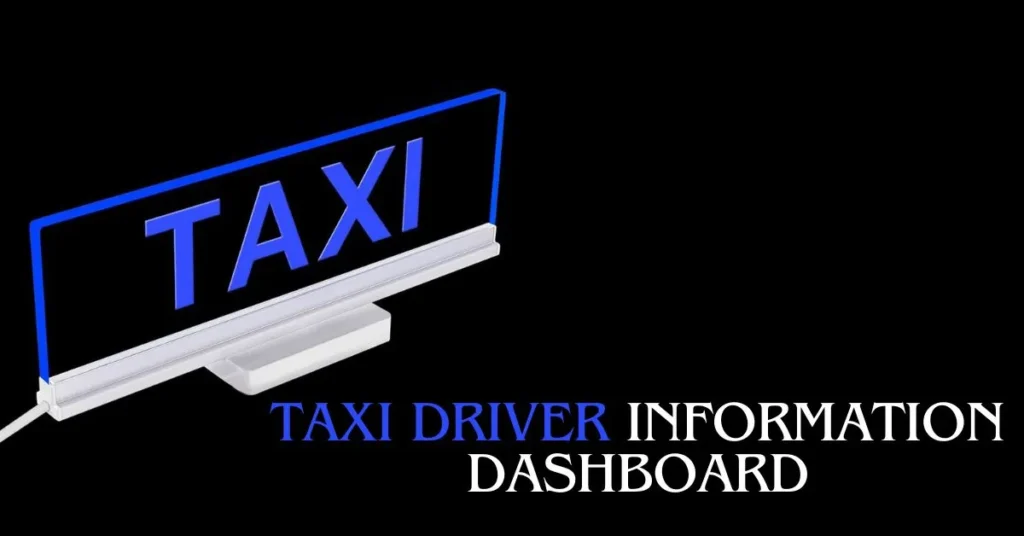In the fast-paced world of urban transportation, staying ahead of the curve is crucial. For taxi drivers, a well-designed information dashboard can be a game-changer, providing essential data at a glance. If you’re a taxi driver or part of a fleet management team, understanding how to leverage a taxi driver information dashboard can boost efficiency, safety, and customer satisfaction. In this comprehensive guide, we’ll explore everything you need to know about these dashboards, from their key features to the benefits they offer. Buckle up, and let’s dive into the world of taxi driver information dashboards!
What is a Taxi Driver Information Dashboard?
A taxi driver information dashboard is an integrated digital platform that consolidates various data points into a single, easily accessible interface. This tool helps drivers manage their trips, navigate routes, monitor vehicle health, and stay informed about real-time traffic conditions.
In the past, drivers relied on multiple devices and manual logs to keep track of their operations. Today, a well-equipped dashboard centralizes all this information, providing a seamless experience that enhances both driver performance and passenger experience.
Key Features of a Taxi Driver Information Dashboard:
A robust taxi driver information dashboard is packed with features designed to streamline operations. Here are some of the most important ones:
Real-Time Navigation and Traffic Updates:
With built-in GPS and real-time traffic data, drivers can avoid congested routes and reach their destinations faster. This feature not only saves time but also improves fuel efficiency and reduces wear and tear on the vehicle.
Trip Management:
Trip management tools help drivers keep track of their daily rides, including start and end times, distances traveled, and earnings. This data can be invaluable for managing finances and identifying peak hours for business.
Vehicle Health Monitoring:
Modern dashboards often include diagnostic tools that monitor the health of the vehicle. Alerts for issues such as low tire pressure, engine problems, or required maintenance can prevent breakdowns and extend the lifespan of the car.
Passenger Information:
Knowing the passenger’s preferences, history, and feedback can help drivers provide a more personalized and satisfactory service. Some dashboards integrate with customer relationship management (CRM) systems to offer this functionality.
Communication Tools:
Effective communication with dispatchers and other drivers is critical for efficient operations. Dashboards often include messaging systems or integration with mobile phones to keep everyone connected.
Enhancing Safety with Dashboards:
Safety is paramount in the taxi industry, and a good dashboard can play a significant role in keeping drivers and passengers safe.
Driver Behavior Monitoring:
Dashboards can track driver behavior, including speed, braking patterns, and adherence to traffic laws. Alerts for unsafe driving practices can help drivers correct their behavior, reducing the risk of accidents.
Emergency Assistance:
In case of emergencies, a dashboard can provide one-touch access to emergency services or fleet managers. Quick access to help can make a crucial difference in urgent situations.
Route History:
Keeping a log of past routes can be useful for security purposes and resolving disputes. This data can also be used to analyze driving patterns and optimize future routes.
Boosting Efficiency and Reducing Costs:
Efficiency is the name of the game in the taxi business. An information dashboard can significantly streamline operations and reduce costs.
Optimized Routing:
By analyzing traffic patterns and historical data, dashboards can suggest the most efficient routes. This optimization reduces fuel consumption and helps drivers complete more rides in less time.
Fuel Management:
Some dashboards include tools to monitor fuel usage and suggest ways to improve efficiency. Keeping track of fuel expenses and identifying trends can help drivers and fleet managers cut costs.
Maintenance Scheduling:
Proactive maintenance is essential for keeping vehicles on the road and avoiding costly repairs. Dashboards can alert drivers to upcoming maintenance needs based on mileage or time intervals, ensuring that cars are always in top condition.
Improving Customer Satisfaction:
Happy customers are repeat customers. Here’s how a taxi driver information dashboard can enhance the passenger experience:
Accurate ETAs:
Providing passengers with accurate estimated times of arrival (ETAs) can improve satisfaction. Dashboards that use real-time data can offer precise ETAs, reducing waiting times and improving overall service quality.
Cashless Payments:
Integration with payment systems allows for smooth, cashless transactions. This convenience is appreciated by passengers and reduces the hassle for drivers.
Feedback and Ratings:
Collecting feedback and ratings through the dashboard can help drivers improve their service. Positive reviews build a good reputation, while constructive criticism provides opportunities for growth.
Adapting to Technological Advances:
Technology in the transportation industry is evolving rapidly, and taxi drivers must keep up with the changes to remain competitive.
Integration with Ride-Hailing Apps:
Many taxi services now integrate with popular ride-hailing apps like Uber and Lyft. A dashboard that supports these integrations can help drivers capture a wider audience and increase their earnings.
AI and Machine Learning:
Artificial intelligence (AI) and machine learning can analyze vast amounts of data to provide insights and recommendations. Dashboards with these capabilities can offer predictive maintenance, demand forecasting, and personalized driving tips.
IoT Connectivity:
The Internet of Things (IoT) connects various devices and sensors to provide comprehensive data about the vehicle and its environment. Dashboards that leverage IoT can offer advanced features like real-time health diagnostics and remote control capabilities.
Overcoming Challenges in Implementation:
While the benefits of a taxi driver information dashboard are clear, implementing one can come with challenges.
Cost Considerations:
High-quality dashboards can be expensive, especially for small fleets or individual drivers. However, the long-term savings and increased earnings often justify the initial investment.
Training and Adaptation:
Learning to use a new dashboard can take time and effort. Providing adequate training and support is essential for a smooth transition. Some drivers may be resistant to change, so emphasizing the benefits and offering hands-on assistance can help.
Data Security:
With so much data being collected and transmitted, security is a major concern. Ensuring that the dashboard system complies with data protection regulations and uses robust encryption methods is crucial.
Case Study: Success Stories from the Field:
To illustrate the impact of a taxi driver information dashboard, let’s look at a real-world example.
City Taxi Service:
City Taxi Service, a mid-sized taxi company, implemented a comprehensive dashboard system for its fleet. Within six months, they saw a 20% increase in efficiency and a 15% reduction in fuel costs. Driver satisfaction improved due to better route planning and communication tools, and customer feedback was overwhelmingly positive, citing accurate ETAs and improved ride experiences.
Choosing the Right Dashboard:
With numerous options on the market, choosing the right dashboard can be daunting. Here are some tips to make the decision easier:
Assess Your Needs:
Consider what features are most important for your operations. Do you need advanced navigation, detailed vehicle diagnostics, or robust communication tools? Make a list of must-have features before you start shopping.
Compare Options:
Look at multiple products and compare their features, prices, and user reviews. Consider reaching out to other drivers or fleet managers for their recommendations.
Test Before You Buy:
If possible, take the dashboard for a test drive. Many providers offer demo versions or trial periods, allowing you to see how the system performs in real-world conditions.
Future Trends in Taxi Driver Information Dashboards:
The future of taxi driver information dashboards is bright, with many exciting developments on the horizon.
Autonomous Vehicles:
As autonomous vehicle technology advances, dashboards will play a crucial role in monitoring and controlling these cars. While fully autonomous taxis are still in development, the data and insights provided by dashboards will be essential for their safe operation.
Enhanced Connectivity:
5G technology and improved IoT devices will make dashboards more powerful and reliable. Real-time data transmission will be faster and more accurate, enabling even better decision-making.
Eco-Friendly Features:
With increasing emphasis on sustainability, future dashboards will likely include more eco-friendly features. These might include tools for optimizing electric vehicle performance, monitoring carbon footprints, and suggesting greener driving practices.
Conclusion:
A taxi driver information dashboard is more than just a technological upgrade; it’s a transformative tool that can revolutionize the way drivers operate. From improving safety and efficiency to enhancing customer satisfaction and adapting to future trends, the benefits are clear. By investing in the right dashboard and staying ahead of technological advancements, taxi drivers and fleet managers can ensure a smoother, more profitable ride for everyone involved.
So, if you’re ready to take your taxi service to the next level, consider implementing a comprehensive information dashboard. Your passengers will thank you, and you’ll wonder how you ever managed without it.







